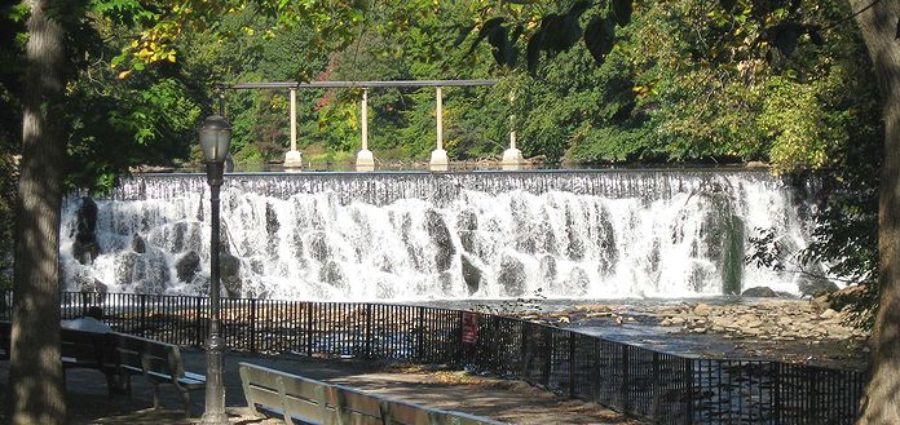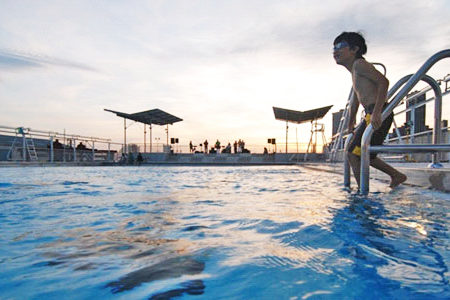Bronx Park boasts some of the city’s most beautiful outdoor space and ecologically diverse wildlife. A myriad of plants and animals make their habitat along the Bronx River and in the park’s forests. The vastness of the park and the diversity of its flora and fauna make Bronx Park one of the true hidden gems of New York City.



The Bronx River, which begins in North White Plains and flows into the East River at Soundview Park, offers numerous scenic and recreational opportunities. While walking along the river, visitors can observe a unique habitat which hosts a diverse array of invertebrates, fish, and birds. The two-mile stretch of river in Bronx Park runs through a deep gorge, where a combination of red maple hardwood swamp and floodplain forest grows on the riverbanks.
While the park is perhaps best known as the home of the Bronx Zoo and New York Botanical Garden, Bronx Park also has many recreation areas. Park visitors can take advantage of numerous playgrounds, bicycle paths, baseball diamonds, tennis and basketball courts and football and soccer fields. From zoos to playgrounds to historical landmarks, Bronx Park is an area for all to enjoy.
Bronx Park, like the surrounding borough and the river that runs through it, is named for the 17th century Swedish sea captain who settled the area, Jonas Bronck (1600-1643). Bronck, a sea captain born in Sweden, settled in the area now named for him in 1639. The Swedish navigator purchased approximately 500 acres of land from the Dutch West India Company, and traded tools, clothes, and utensils with local Native Americans for additional property. He built a stone home in what is now Morrisania, and owned one of the largest collections of books in the colony. Bronck’s estate also played host to a peace conference with the Weckquasgeck Indians in 1642.
After Bronck, this property passed through several different families before the city acquired 640 acres of it between December 1888 and January 1889. Inspiration for Bronx Park came during a widespread movement to create public parks throughout the city in the 1880s. In 1881, John Mullaly (1835-1915), a former newspaper reporter and editor, and a group of citizens concerned with widespread urban growth formed the New York Park Association. The group’s lobbying efforts helped the passage of the New Parks Act in 1884, which funded the acquisition of several major undeveloped lands for the purpose of creating parks and parkways. By 1890, the city had acquired properties in the Bronx that would eventually become known as the Van Cortlandt, Pelham Bay, Bronx, Crotona, and Claremont parks, as well as four parkways. John Mullaly Park, an 18-acre parkland in the Highbridge section of the Bronx, was dedicated to the park buy levitra canada activist in 1932.
In 1891, 250 acres of this site were allotted to the New York Botanical Society. The New York Botanical Garden was modeled after the Royal Botanical Gardens in Kew, England and has become one of the most distinguished gardens in the world. The New York Botanical Garden houses living collections of temperate and tropical plants from all over the world as well as a huge collection of preserved plant specimens. It is also home to a 40-acre “virgin” forest, the last such preserve in the city.
The City of New York allotted another 250 acres to the New York Zoological Society in 1898 to build a park to preserve native animals and to promote zoology. The Wildlife Conservation Park, better known as the Bronx Zoo, opened in 1899 and remains one of the largest wildlife conservation parks in the United States. The zoo’s 4,000 animals represent more than 650 species! In 1906, the city acquired another 66 acres on the southeast end of this property. This area currently houses Ranaqua, Parks’ Bronx headquarters.
Bronx Park is home to many monuments presented to the city, such as the Rainey Memorial Gate, an ornamental gate with 22 full-sized sculpted animals located at the Fordham Road entrance to the zoo. Created by architect Paul Manship (1885-1966) and dedicated in 1934, the monument honors Paul J. Rainey (1877-1923), a Big Game hunter and patron of the zoo. The gate, with its “tree of life” motif, is one of the few examples in New York City of the French Arts Decoratifs style.
Another historic landmark is a souvenir from the Ice Age known as the Rocking Stone. Located in Bronx Zoo overlooking the Buffalo Range, the stone is a rough cube of pinkish granite, resting on a granite slab base. This relic, roughly seven feet high and weighing around 30 tons, is precisely balanced and cannot be moved. On the grounds of the New York Botanical Garden stand an old snuff mill and other architectural remnants of the area’s last private owner, the Lorillard family.
In addition to its rich history and diverse scenery, Bronx Park has many recreation areas including playgrounds, bicycle paths, baseball diamonds, tennis and basketball courts and football and soccer fields. From zoos to playgrounds to historical landmarks, Bronx Park is an area for all to enjoy.
Please folow the directions below to get to Bronx Park.
By car:
From the Bronx River Parkway, take Exit 8E for Kazimiroff Boulevard. Parking is available along Bronx Park East.
By bus:
-BX19, BX9, BX36 or BXM11 to Bronx Zoo
-BX41, BX55, or BX26 to Webster Avenue & Bedford Park Boulevard
-BX34 to Bainbridge Avenue & Bedford Park Boulevard
By subway:
-B/D to Bedford Park Boulevard Station
-2/5 to East 180 Street








